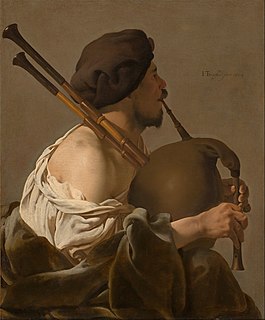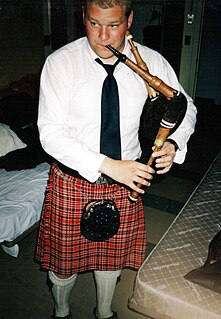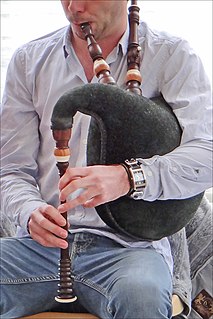Sources
- http://www.cornemuses.culture.fr%5B%5D (in French)
| This article relating to musical instruments is a stub. You can help Wikipedia by expanding it. |
The musette bressane (or mezeta, mus'ta, voire cabrette, brette or tchievra) is a type of bagpipe native to the historic French province of Bresse, in eastern France.
The instrument consists of one chanter with a double reed and conical bore, a high drone set in the same stock (which may have a single, or rarely a double, reeded drone), and a large bass drone with a single reed.
These bagpipes are currently generally bellows-blown, though their predecessors prior to 1800 were mouth-blown.
| This article relating to musical instruments is a stub. You can help Wikipedia by expanding it. |

Bagpipes are a woodwind instrument using enclosed reeds fed from a constant reservoir of air in the form of a bag. The Scottish Great Highland bagpipes are the best known in the Anglophone world; however, bagpipes have been played for a millennium or more throughout large parts of Europe, northern Africa, and western Asia, including Anatolia, the Caucasus, and around the Persian Gulf. The term bagpipe is equally correct in the singular or plural, though pipers usually refer to the bagpipes as "the pipes", "a set of pipes" or "a stand of pipes".

The uilleann pipes are the characteristic national bagpipe of Ireland. Earlier known in English as "union pipes", their current name is a partial translation of the Irish-language term píobaí uilleann, from their method of inflation. There is no historical record of the name or use of the term uilleann pipes before the twentieth century. It was an invention of Grattan Flood and the name stuck. People mistook the term 'union' to refer to the 1800 Act of Union; this is incorrect as Breandán Breathnach points out that a poem published in 1796 uses the term 'union'.
Hornbostel–Sachs or Sachs–Hornbostel is a system of musical instrument classification devised by Erich Moritz von Hornbostel and Curt Sachs, and first published in the Zeitschrift für Ethnologie in 1914. An English translation was published in the Galpin Society Journal in 1961. It is the most widely used system for classifying musical instruments by ethnomusicologists and organologists. The system was updated in 2011 as part of the work of the Musical Instrument Museums Online (MIMO) Project.

The chanter is the part of the bagpipe upon which the player creates the melody. It consists of a number of finger-holes, and in its simpler forms looks similar to a recorder. On more elaborate bagpipes, such as the Northumbrian bagpipes or the Uilleann pipes, it also may have a number of keys, to increase the instrument's range and/or the number of keys it can play in. Like the rest of the bagpipe, they are often decorated with a variety of substances, including metal (silver/nickel/gold/brass), bone, ivory, or plastic mountings.

Zampogna is a generic term for a number of Italian double chantered pipes that can be found as far north as the southern part of the Marche, throughout areas in Abruzzo, Latium, Molise, Basilicata, Campania, Calabria, and Sicily. The tradition is now mostly associated with Christmas, and the most famous Italian carol, "Tu scendi dalle stelle" is derived from traditional zampogna music. However, there is an ongoing resurgence of the instrument in secular use seen with the increasing number of folk music festivals and folk music ensembles.
The arghul, also spelled argul, arghoul, arghool, argol, or yarghul, is a musical instrument in the reed family. It has been used since Ancient Egyptian times and is still used as a traditional instrument in Egypt and Palestine.

The term double clarinet refers to any of several woodwind instruments consisting of two parallel pipes made of cane, bird bone, or metal, played simultaneously, with a single reed for each. Commonly, there are five or six tone holes in each pipe, or holes in only one pipe while the other acts as a drone, and the reeds are either cut from the body of the instrument or created by inserting smaller, slit tubes into the ends of the pipes. The player typically uses circular breathing.

A single-reed instrument is a woodwind instrument that uses only one reed to produce sound. The very earliest single-reed instruments were documented in ancient Egypt, as well as the Middle East, Greece, and the Roman Empire. The earliest types of single-reed instruments used idioglottal reeds, where the vibrating reed is a tongue cut and shaped on the tube of cane. Much later, single-reed instruments started using heteroglottal reeds, where a reed is cut and separated from the tube of cane and attached to a mouthpiece of some sort. By contrast, in a double reed instrument, there is no mouthpiece; the two parts of the reed vibrate against one another. Reeds are traditionally made of cane and produce sound when air is blown across or through them.

The musette de cour or baroque musette is a musical instrument of the bagpipe family. Visually, the musette is characterised by the short, cylindrical shuttle-drone and the two chalumeaux. Both the chanters and the drones have a cylindrical bore and use a double reed, giving a quiet tone similar to the oboe. The instrument is blown by a bellows.

Welsh bagpipes The names in Welsh refer specifically to a bagpipe. A related instrument is one type of bagpipe chanter, which when played without the bag and drone is called a pibgorn (English:hornpipe). The generic term pibau (pipes) which covers all woodwind instruments is also used. They have been played, documented, represented and described in Wales since the fourteenth century. A piper in Welsh is called a pibydd or a pibgodwr.
The volynka is a bagpipe. Its etymology comes from the region Volyn, Ukraine, where it was borrowed from Romania.

The Zetland pipes were a type of bagpipe designed and crafted by Pipe Major Royce Lerwick in the 1990s.

Variants of the bock, a type of bagpipe, were played in Central Europe in what are the modern states of Austria, Germany, Poland and the Czech Republic. The tradition of playing the instrument endured into the 20th century, primarily in the Blata, Chodsko, and Egerland regions of Bohemia, and among the Sorbs of Saxony. The name "Bock" refers to the use of goatskins in constructing the bag, similar to the common use of other goat-terms for bagpipes in other nations, such as the French cabrette.

The veuze is a Breton bagpipe found traditionally in southeastern Brittany and in the northern part of the Vendée, particularly around Nantes, the Guérande peninsula, and Basse-Vilaine. The veuze has been mentioned in writings dating to the 16th century, and is thought to be the oldest of the Breton bagpipes. The veuze is thought to be the antecedent of the biniou.

Doedelzak is the actual generic term for the bagpipes in the Netherlands and the Flemish (Dutch) speaking northern part of Belgium. This is the region where painter Pieter Bruegel the Elder lived and worked. Formerly 'pijpzak' and 'moezelzak' were common. The latter two names, generic at one time, survive in the piposa from Picardy and muchosa in the actual Belgian province of Hainaut. According to certain sources, muse once was the earliest generic name for this family of instruments in a large part of Europe and survives itself in the actual French generic name of cornemuse for all bagpipes.
The cornemuse du Centre France is a type of bagpipes native to Central France. They have two drones, one an octave below the tonic of the chanter, and the other two octaves below the tonic of the chanter. They can be found in the Bourbonnais, Berry, Nivernais, and Morvan regions of France and in different tonalities.

Bodega or craba is an Occitan term for a type of French bagpipe played in Montagne Noire, particularly within the French departments of Tarn, Aude, Hérault, and Haute-Garonne. It is also the name given to outdoor bars or cellars with festive music during ferias.
Reed aerophones is one of the categories of musical instruments found in the Hornbostel-Sachs system of musical instrument classification. In order to produce sound with these Aerophones the player's breath is directed against a lamella or pair of lamellae which periodically interrupt the airflow and cause the air to be set in motion.